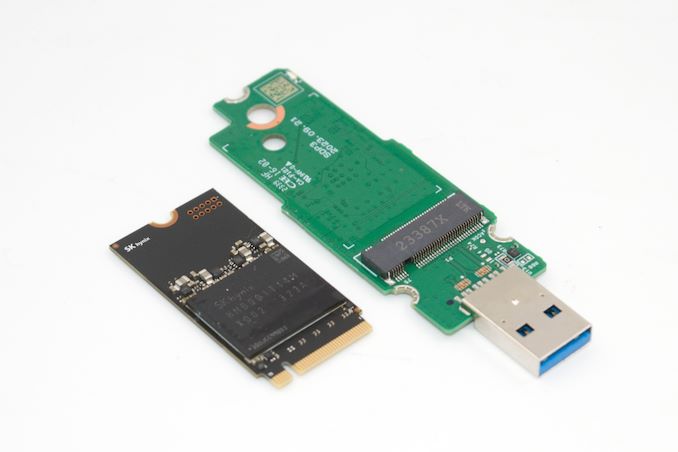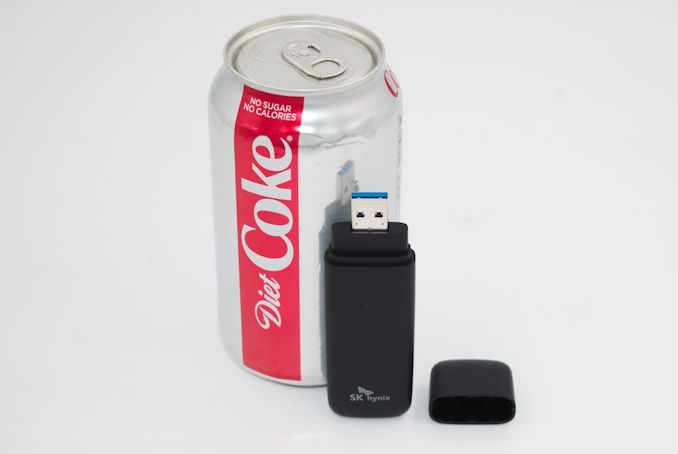
Original Link: https://www.anandtech.com/show/21338/sk-hynix-tube-t31-stick-ssd-review-bridging-solution-springs-a-surprise
SK hynix Tube T31 Stick SSD Review: Bridging Solution Springs A Surprise
by Ganesh T S on April 15, 2024 8:00 AM EST- Posted in
- Storage
- SSDs
- flash
- DAS
- JMicron
- SK Hynix
- USB 3.2 Gen 2
- Portable SSDs
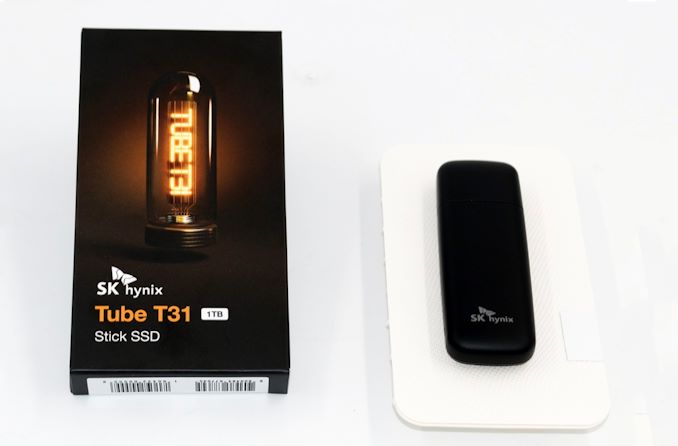
SK hynix is one of the few vertically integrated manufacturers in the flash-based storage market (along with Samsung, Micron / Crucial, Western Digital, and Kioxia). The company is well-established in the OEM market. A few years back, they also started exploring direct end-user products. Internal SSDs (starting with the Gold S31 and Gold P31) were the first out of the door. Late last year, the company introduced the Beetle X31 portable SSD, its first direct-attached storage product. In February, a complementary product was introduced - the Tube T31 Stick SSD.
The Beetle X31 is a portable SSD with a Type-C upstream port and a separate cable. The Tube T31 is a take on the traditional thumb drive with a male Type-A interface. The size of the Beetle X31 makes the use of a bridge solution obvious. Our investigation into the Tube T31 also revealed the use of the same internal SSD, albeit with a different bridge. This review takes a detailed look at the Tube T31, including an analysis of its internals and evaluation of its performance consistency, power consumption, and thermal profile.
Introduction and Product Impressions
USB flash drives have grown both in storage capacity and speeds over the last few years. Thanks to the advent of 3D NAND and rapid iterations with performance improvements in the USB specifications, we are now seeing 'stick SSDs' capable of delivering 1GBps+ speeds. This market segment has slowly been gaining members since the introduction of the Kingston's DataTraveler Max in late 2021. Some stick SSD vendors have attempted to differentiate themselves by even offering 2TB SKUs.
The high-performance 'stick SSD' segment is relatively new, and has been dominated by native UFD controllers (Silicon Motion's SM2320 in products such as the Kingston DataTraveler Max A and Transcend ESD310C, and the Phison U17 in the OWC Envoy Pro Mini for example). This is in contrast to early high-performance UFDs such as the Corsair Voyager GTX and the Mushkin Ventura Ultra which employed a SATA SSD controller behind a USB 3.0 bridge. In high-performance scenarios, the bridge solution is usually avoided for UFDs due to thermal constraints. BOM cost is also another important aspect, as UFDs usually tend / need to be priced lower than portable SSDs. Factors such as the absence of a separate cable help with that, but a bridge solution in the PCB could potentially offset the savings.
The Beetle X31 from SK hynix was a traditional portable SSD that employed a SK hynix BC711 M.2 2242 NVMe SSD behind an ASMedia ASM2362 USB 3.2 Gen 2 bridge chip. Unlike other PSSD families with a wide range of capacity options, the Beetle X31 was introduced with only two capacity options - 512GB and 1TB. The reason ended up being the single-chip BC711 internal SSD - the package integrates the flash dies, SSD controller, and DRAM for the flash translation layer as well. The highly integrated nature of the BC711 ended up limiting the number of NAND dies, and hence the limited capacity options.
The Tube T31 being reviewed today also comes in the same two capacity points - 512GB and 1TB, pointing to the likely use of the same internal SSD. The integration of the flash dies and the controller in a single package alleviates some of the BOM concerns, and a bridge-based solution based on the BC711 ends up with a similar PCB area to a native UFD controller-based solution.
The Tube T31 is relatively bulky for a USB flash drive, and is bound to interfere with devices / cables connected to neighboring USB ports. However, the dimensions are unavoidable due to the use of a M.2 2242 internal SSD and its associated thermal solution. Since this is a UFD solution, the packaging is spartan - just the user manual and the main unit in an environment-friendly recyclable box.
The clamshell case design is easily disassembled by pushing in the plastic tabs holding both sides to enable one of them to pop up and slide off. The circuit boards are shielded by a metal cladding that is held together with the aid of three screws, and further affixed to the boards with thermal pads - one on top of the bridge chip in the main board, and the other across the NVMe SSD daughterboard.
The internal SSD is a single-sided board, with a thin thermal pad on the underside used to keep it glued to the main board.
The single chip on the SSD carries the 'SK hynix HNB001T14M' package marking - which is the same as the one in the BC711 M.2 2230 / 2242 OEM NVMe SSD. This uses SK hynix's 128L V6 NAND, and integrates their in-house controller as well as DRAM.
Unlike the ASMedia ASM2362 used in the Beetle X31, SK hynix has opted for JMicron's JMS583 in the Tube T31. The JMicron solution has been around for more than 5 years now, and is currently on A3 silicon (fourth iteration of the same design with silicon bug fixes) to improve and resolve system incompatibility issues. This bridge seems to have had a recent resurgence in the market, evidenced by its use in the Silicon Power PX10 released earlier this year.
The bridge allows S.M.A.R.T passthrough, as shown in the CrystalDiskInfo screenshot below. TRIM is also available, even though it doesn't find an explicit mention.
| Comparative Direct-Attached Storage Devices Configuration | ||
| Aspect | ||
| Downstream Port | PCIe 3.0 x2 | Native Flash |
| Upstream Port | USB 3.2 Gen 2 Type-A | USB 3.2 Gen 2 Type-C (Male) |
| Bridge Chip | JMicron JMS583-A3 | Silicon Motion SM2320 |
| Power | Bus Powered | Bus Powered |
| Use Case | Light-weight 1GBps-class stick SSD marketed as a thumb drive alternative, with focus on performance consistency | 1GBps-class, compact USB thumb drive with retractable cover for Type-C connector |
| Physical Dimensions | 92.5 mm x 30.5 mm x 14 mm | 82.6 mm x 22.3 mm x 9.5 mm |
| Weight | 34 grams | 12.5 grams |
| Cable | N/A | N/A |
| S.M.A.R.T Passthrough | Yes | Yes |
| UASP Support | Yes | Yes |
| TRIM Passthrough | Yes | Yes |
| Hardware Encryption | No | Not Available |
| Evaluated Storage | SK hynix BC711 (SK hynix V6 128L 3D TLC) | Micron 96L 3D TLC |
| Price | $85 $100 |
USD 180 |
| Review Link | SK hynix Tube T31 1TB Review | Kingston DT Max 1TB Review |
Prior to looking at the benchmark numbers, power consumption, and thermal solution effectiveness, a description of the testbed setup and evaluation methodology is provided.
Testbed Setup and Evaluation Methodology
Direct-attached storage devices (including thumb drives) are evaluated using the Quartz Canyon NUC (essentially, the Xeon / ECC version of the Ghost Canyon NUC) configured with 2x 16GB DDR4-2667 ECC SODIMMs and a PCIe 3.0 x4 NVMe SSD - the IM2P33E8 1TB from ADATA.
The most attractive aspect of the Quartz Canyon NUC is the presence of two PCIe slots (electrically, x16 and x4) for add-in cards. In the absence of a discrete GPU - for which there is no need in a DAS testbed - both slots are available. In fact, we also added a spare SanDisk Extreme PRO M.2 NVMe SSD to the CPU direct-attached M.2 22110 slot in the baseboard in order to avoid DMI bottlenecks when evaluating Thunderbolt 3 devices. This still allows for two add-in cards operating at x8 (x16 electrical) and x4 (x4 electrical). Since the Quartz Canyon NUC doesn't have a native USB 3.2 Gen 2x2 port, Silverstone's SST-ECU06 add-in card was installed in the x4 slot. All non-Thunderbolt devices are tested using the Type-C port enabled by the SST-ECU06.
The specifications of the testbed are summarized in the table below:
| The 2021 AnandTech DAS Testbed Configuration | |
| System | Intel Quartz Canyon NUC9vXQNX |
| CPU | Intel Xeon E-2286M |
| Memory | ADATA Industrial AD4B3200716G22 32 GB (2x 16GB) DDR4-3200 ECC @ 22-22-22-52 |
| OS Drive | ADATA Industrial IM2P33E8 NVMe 1TB |
| Secondary Drive | SanDisk Extreme PRO M.2 NVMe 3D SSD 1TB |
| Add-on Card | SilverStone Tek SST-ECU06 USB 3.2 Gen 2x2 Type-C Host |
| OS | Windows 10 Enterprise x64 (21H1) |
| Thanks to ADATA, Intel, and SilverStone Tek for the build components | |
The testbed hardware is only one segment of the evaluation. Over the last few years, the typical direct-attached storage workloads for memory cards have also evolved. High bit-rate 4K videos at 60fps have become quite common, and 8K videos are starting to make an appearance. Game install sizes have also grown steadily even in portable game consoles, thanks to high resolution textures and artwork. Keeping these in mind, our evaluation scheme for portable SSDs and UFDs involves multiple workloads which are described in detail in the corresponding sections.
- Synthetic workloads using CrystalDiskMark and ATTO
- Real-world access traces using PCMark 10's storage benchmark
- Custom robocopy workloads reflective of typical DAS usage
- Sequential write stress test
In the next section, we have an overview of the performance of the SK hynix Tube T31 in these benchmarks. Prior to providing concluding remarks, we have some observations on the stick SSD's power consumption numbers and thermal solution also.
Performance Benchmarks
Benchmarks such as ATTO and CrystalDiskMark help provide a quick look at the performance of the direct-attached storage device. The results translate to the instantaneous performance numbers that consumers can expect for specific workloads, but do not account for changes in behavior when the unit is subject to long-term conditioning and/or thermal throttling. Yet another use of these synthetic benchmarks is the ability to gather information regarding support for specific storage device features that affect performance.
Synthetic Benchmarks - ATTO and CrystalDiskMark
SK hynix claims sequential read and write speeds of up to 1000 MBps. Based on the ATTO benchmarks below, it appears that SK hynix has been a bit conservative in its write speed claims. ATTO benchmarking is restricted to a single configuration in terms of queue depth, and is only representative of a small sub-set of real-world workloads. It does allow the visualization of change in transfer rates as the I/O size changes, with optimal performance being reached around 512 KB for a queue depth of 4.
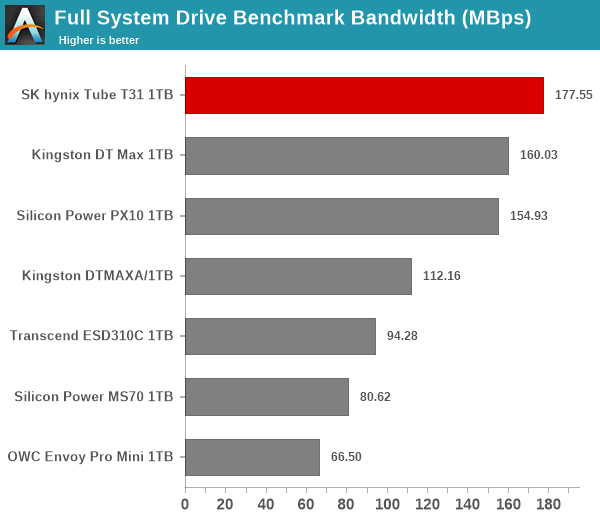
Given the domination of the Tube T31 across a majority of the workloads, it is no surprise that the stick SSD clinches the top spot in the overall scores by a significant margin.
Miscellaneous Aspects and Concluding Remarks
The performance of different stick SSDs in various real-world access traces as well as synthetic workloads was brought out in the preceding sections. We also looked at the performance consistency for these cases. Power users may also be interested in performance consistency under worst-case conditions, as well as drive power consumption. The latter is also important when used with battery powered devices such as notebooks and smartphones. Pricing is also an important aspect. We analyze each of these in detail below.
Worst-Case Performance Consistency
Flash-based storage devices tend to slow down in unpredictable ways when subject to a large number of small-sized random writes. Many benchmarks use that scheme to pre-condition devices prior to the actual testing in order to get a worst-case representative number. Fortunately, such workloads are uncommon for direct-attached storage devices, where workloads are largely sequential in nature. Use of SLC caching as well as firmware caps to prevent overheating may cause drop in write speeds when a flash-based DAS device is subject to sustained sequential writes.
Our Sequential Writes Performance Consistency Test configures the device as a raw physical disk (after deleting configured volumes). A fio workload is set up to write sequential data to the raw drive with a block size of 128K and iodepth of 32 to cover 90% of the drive capacity. The internal temperature is recorded at either end of the workload, while the instantaneous write data rate and cumulative total write data amount are recorded at 1-second intervals.
| CrystalDiskMark Workloads - Power Consumption | |
| TOP: | BOTTOM: |
 |
|
 |
|
The SK hynix Tube T31 has a peak power consumption in the CrystalDiskMark workloads of 4.27W. This is 2x to 3x of the numbers seen in other stick SSDs, and approximately the same as the only other bridge-based PSSD in the mix. SK hynix's controller and NAND flash are reputed for their low power consumption, and despite the DRAM in the package, the numbers are similar to that of the DRAM-less bridge-based Silicon Power PX10 PSSD. It is also heartening to see a low-power idle state (0.02W) that is helpful when the stick SSD is used with battery-powered hosts.
Final Words
The SK hynix Tube T31 was introduced into the market a couple of months after the Beetle X31. Both external SSDs use the same core - the SK hynix BC711 OEM SSD. SSD prices are slowly on the rise, thanks to the rebound in the flash market. Unfortunately, that also means prices for SSDs are not going to be consistent across different retailers. The 1TB SKU is for sale on Newegg at $85 and Amazon at $100. SK hynix also has a 512GB variant that is priced at $70 (Newegg) / $80 (Amazon). Prices of all PSSDs are in a flux and it is not possible to make any comments on the value proposition (either standalone or on a comparative basis) of the Tube T31 at this point in time.
A fully plastic enclosure for a board with such high power consumption (and, as a result, higher thermal load) is not preferable. Even if part of the casing were to be made of metal, complaints of smelly plastic under high load / case warmth could be avoided. Despite being advertised as a stick SSD, the casing is quite bulky and bound to cause port congestion in most systems if nearby USB ports are also occupied. The Type-A only nature could be a deal-breaker for some systems, but we found the drive to work with advertised specifications even with off-the-shelf USB 3.2 Gen Type-A to Type-C adapters (including the adapter bundled with the Silicon Power MS70). The connector-protecting cap is not attached to the main section of the casing. Some thumb drives allow for the cap to be attached to the rear end when the drive is in active use, but the Tube T31 has no such feature. As such, some users may end up misplacing the cap.
Stick SSDs with bridge-based internals are rare, and rightly so - there are power consumption, BOM cost, and thermal design challenges involved that are largely solved by going in for a native flash controller. The SK hynix Tube T31 is able to address aspects such as BOM cost by integrating the DRAM, SSD controller, and NAND flash in a single package. However, power numbers are still too high for a thumb drive. This tight integration also means that SK hynix only markets two capacity points for the Tube T31 - 512GB and 1TB. On the performance front, the drive performs in an excellent manner (as advertised) as long as the workload set is kept within reasonable numbers for both reads and writes.
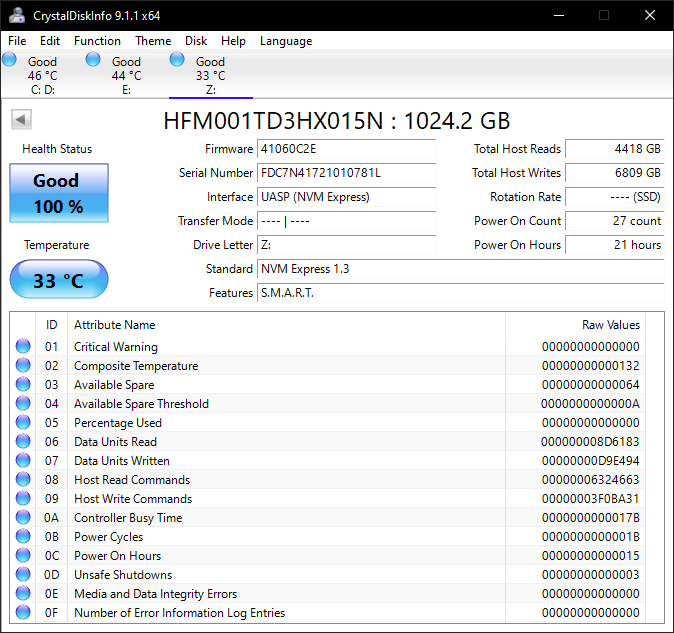
6.8TB+ writes, and 4TB+ reads at the end of our testing routine
The SLC cache size (40% of user capacity in our 1TB review sample out of the box) is quite high for a stick SSD / thumb drive. For casual users, this results in satisfactory performance for normal workloads. The Tube T31 is a unique stick SSD considering the fact that it is the only one we are aware of with a DRAM-equipped internal SSD. This enables the thumb drive to provide class-leading true SSD performance for workloads such as OS booting and office document work involving large number of random accesses.
The SK hynix BC711 is a nifty M.2 2242 SSD (it even has a M.2 2230 avatar, thanks to the integration of all necessary SSD components in a single package). In PSSDs such as the Beetle X31, it is easy to recommend. On the contrary, its characteristics make it a bit of a mixed bag for the thumb-drive form factor. Make no mistake - the performance benefits are quite welcome, but we would have liked it better in a more suitable casing with optimized power consumption numbers.








